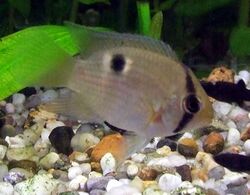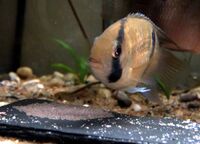Biology:Keyhole cichlid
| Keyhole cichlid | |
|---|---|

| |
| Scientific classification | |
| Domain: | Eukaryota |
| Kingdom: | Animalia |
| Phylum: | Chordata |
| Class: | Actinopterygii |
| Order: | Cichliformes |
| Family: | Cichlidae |
| Subfamily: | Cichlinae |
| Tribe: | Cichlasomatini |
| Genus: | Cleithracara |
| Species: | C. maronii
|
| Binomial name | |
| Cleithracara maronii (Steindachner, 1881)
| |
| Synonyms | |
| |
The keyhole cichlid (Cleithracara maronii) is a cichlid fish endemic to tropical South America, occurring in the lower Orinoco Basin in Venezuela and river basins in The Guianas.[1] It is the only species in the genus Cleithracara.[2] The species is popular with fishkeeping hobbyists and is frequently kept in aquariums.[2][3]
Appearance
The species is a small tan coloured ovate-bodied fish. It has a black spot on its upper flank which sometimes extends into a short stripe. This gives rise to the common name, keyhole cichlid, from which the genus name Cleithracara (meaning "lock acara") is derived.[4] When the species is startled or nervous it assumes a blotchy colouration and presses its body against rocks or logs in an attempt to camouflage itself.[1][3] It is generally shy, peaceful and should not be kept with aggressive species.
Reproduction and sexual dimorphism
It is a monogamous, biparentally custodial breeder which spawns on flattened rocks, logs or leaves.[2] Clutch size ranges from 300-400 eggs that are tended by both the male and female.[1][3] The sexes are difficult to distinguish, though some males have a longer and more pointed dorsal fin. There has been a sighting of a keyhole cichlid laying 1000 eggs[citation needed].
Diet
The species feeds on crustaceans, insects and other invertebrates.[1]
In the aquarium
The species is suitable for the community aquarium and will accept a wide variety of prepared fish food in captivity. The environment in aquaria should mimic the natural habitat of the species and include plants and numerous hiding places. It will also eat beetles that have been dropped in the tank.
See also
- List of freshwater aquarium fish species
References
- ↑ 1.0 1.1 1.2 1.3 Froese, Rainer and Pauly, Daniel, eds. (2013). "Cleithracara maronii" in FishBase. May 2013 version.
- ↑ 2.0 2.1 2.2 Loiselle PV. (1994) The Cichlid Aquarium, Voyageur Press, ISBN:1-56465-146-0
- ↑ 3.0 3.1 3.2 Riehl, Rüdiger. Editor.; Baensch, HA (1996). Aquarium Atlas (5th ed.). Germany: Tetra Press. ISBN 3-88244-050-3.
- ↑ Kullander SO (2003) Cleithracara Guide To The South American Cichlidae
Wikidata ☰ Q795072 entry
 |


